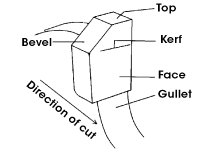Model:
Your Model No.:
Mfr. Model No.:


Teeth can have a single bevel, two bevels or no bevel at all. Types of bevels can alternate from tooth to tooth on a given blade. The bevel is what gives the blade its specific cutting pattern.
This is the space between teeth that clears the work piece of chips after the cut. The deeper the gullet, the more efficiently chips are cleared.
这是牙齿的脸,实际的铜tting takes place. The pattern of alternating kerfs, known as the grind, decides what applications a blade is best for.
There are many types of grinds, but the five basic ones are:

Best for ripping.

For crosscutting, cut-off and trimming.

Perfect for hard, abrasive materials like non-ferrous metals, hardwoods and plastics.

For ripping and crosscutting, mitre.

Combination grind.
Max quantity is 999999999. Your cart item has been updated
Model:
Your Model No.:
Mfr. Model No.:
Qty.: